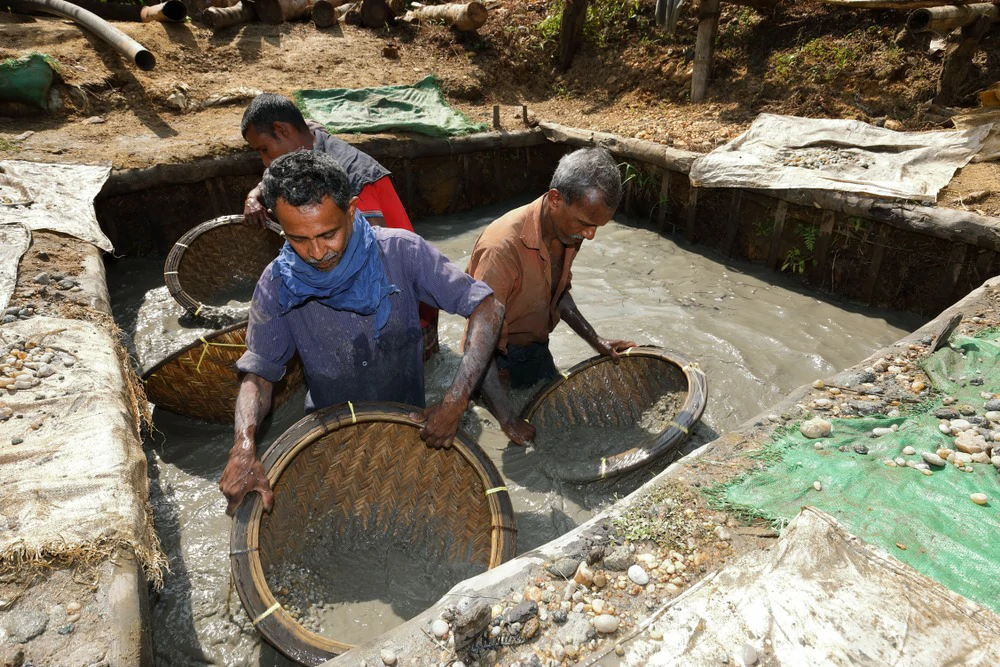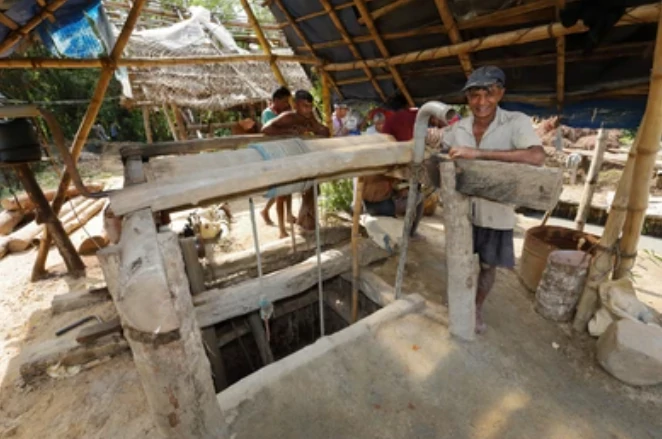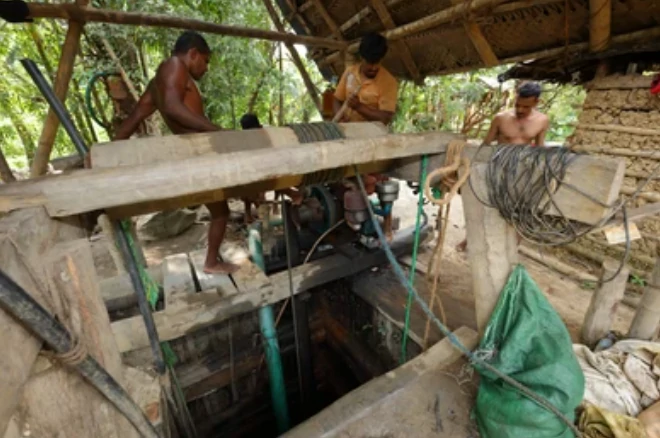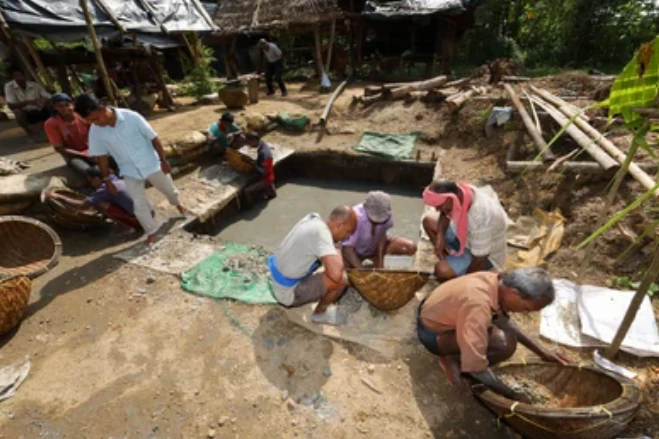
GEM MINING & ENVIRONMENT
Sri Lanka has been famous from time immemorial for the great variety and abundance of gem minerals of extremely high quality and uniqueness, earned it the name Ratna Deepa meaning Gem Island. Nature in her bounty has chosen the bosom of Sri Lanka to enshrine some of her rarest treasures. Significant gem fields had been known from ancient times. Blue Sapphires, Cat’s Eyes, Alexandrite’s, Rubies, Star stones found embedded in layer of gravel and sand, in river beds, marshes, fields or accumulated at the foot of hills have made Sri Lanka the renowned island for gems (Gem Mining). These precious stones perfected in the laboratory of nature lay hidden of countless ages, their luster undimmed, their value unrecognized.
Sri Lanka ranks with Myanmar, Brazil, South Africa and Thailand as one of the world’s most important gem bearing nations. The story of Sri Lanka’s gems is as old as civilization itself. Legends, myths and the occult have been associated with the long history of the island’s precious stoles. Gems are deeply embedded in the traditional beliefs and the religious life of the majority of Sri Lankans. The Arabs called this the land Jazirat Kakut, which denotes the same meaning the Island of gems. The fame of her gems spread far and wide. These priceless precious stones have adorned the crowns and thrones of royalty in many parts of the world. Sri Lanka sapphires are universally renowned for their magnificent quality and the large sizes in which these sometimes occur. Over the years Sri Lanka has graduated to this prestigious position of begin the producer of the world’s best sapphires. Today there is undisputed, unchallenged acceptance that Sri Lanka’s blue sapphires of high quality are supreme.
Unveiling the Secrets of Gemstone Mining

Methods of Gem Mining
Gem mines generally fall into two categories;
(a) Pit mines, and
(b) Riverbed mines
Pit Mines
if gem deposits are located near the surface, shallow circular pits are dug. Depth of a shallow pit can be only a few meters. Deep mine pits are rectangular in shape and may have a depth of well or shaft over 50 meters. In deep mines gem deposits are also excavated horizontally creating tunncl to extend from 6 to 9 meters or occasionally even more away from the shaft. The.gravel collected from mines is brought to the surface and then washed and examined in the search for gems.








Riverbed Mines
Mamoties with handles about 10 meters long are used to stir up and collect sediments from the riverbed. A dam across the river is built to collect the sediment. Gems are also mined from riverbed material by using (gravel) suction pumps for extraction of riverbed gravel for gems. This removal
of gravel causes much harm to riverbank stability (control over such operations is very minimum). The Kaki Ganga being a major river has been issued with licenses for gem mining but, there are several hundred illicit miners resorting to manual dredging and mechanical dredging (using suction pumps).





Environmental Impacts of Gem Mining
Gem mining has caused the environment to degrade. Environmental degradation is a process through which the natural environment is compromised in some way, reducing biological diversity and the general health of the environment. This process can be entirely natural in origin, or it can be accelerated or caused by human activities. Many international organizations recognize environmental degradation as one of the major threats facing the planet, since humans have only been given one Earth to work with, and if the environment becomes irreparably compromised, it could mean the end of human existence.
Gem mining has led to a number of environmental and health problems. A major environmental health concern has been the spread of malarial vectors and biological agents of other tropical diseases as a result of stagnant water in abandoned mining pits. The destruction of agricultural land for mining has been a major concern in many areas. Historically these areas were mined and subsequently returned to agricultural activity. Extensive gem mining in the river has led to the collapse of river banks. Banks of the river are damaged due to excavation. Excavated soil is deposited in a haphazard manner, thereby increasing siltation in the river. Gem miners dumped earth, sand, rubble and garbage into the river without least concerned about its environmental damage. River gets muddy due to dewatering of gem pits. Major landslide and flooding are caused by mining as well as deforestation. Mining, particularly gem mining, has been responsible for serious problems of soil erosion and river siltation. Erosion and downstream silting due to mining has caused floods.
Loss of Biodiversity, Biodiversity is important for maintaining balance of the ecosystem in the form of combating pollution, restoring nutrients, protecting water sources and stabilizing climate. Deforestation, global warming, overpopulation and pollution are few of the major causes for loss of biodiversity.
Measures to Reduce the Impacts of Gem mining
When mining activities are implemented without a plan for remediation it leads the environment to degrade. While mining has led to environmental damages, the impacts are largely avoidable and generally far less permanent than other types of mining that rely on toxic chemicals in the extraction process. In fact, gemstone mining does not use any chemicals to recover gemstones. Environmental damages that have occurred are generally due to lack of planning and poor understanding of sustainable environmental practices. However, mining activities can be conducted with environmental management techniques so that agricultural areas and natural ecosystems are restored to their original state.
Here are some regulatory measures to decrease environmental impacts of mining
Too many pits in one place should be banned. Use fines and security deposits effectively to rehabilitate abandoned gem pits, Avoid issuing licenses to defaulters. Prevent illegal gem mining by issuing licenses efficiently. Proper management and monitoring must be maintained. Gem mining activities in Sri Lanka is increasing according to the growing demands. However, a great concern is on whether the large-scale mining methods are environmentally sustainable or not. Indigenous gem mining method has been proven to be sustainable through time until now; no major adverse impacts have been reported. Supplies from indigenous gem mining balance the demand. Large-scale gem mining will result in over-supply and will lead to inevitable decrease in market price. Transformation from small-scale to large-scale gem mining has apparently caused negative effects on the environment and livelihood of local gem miners as well.



